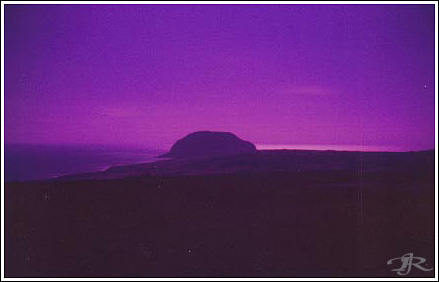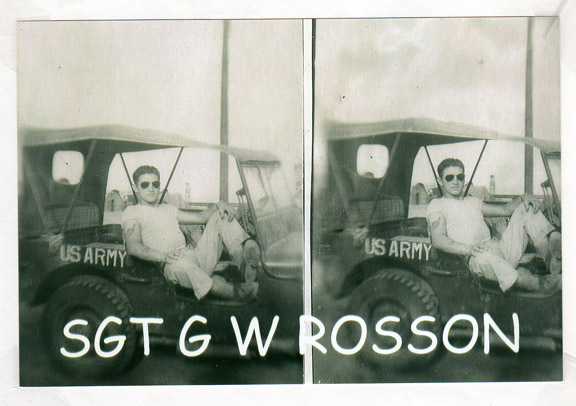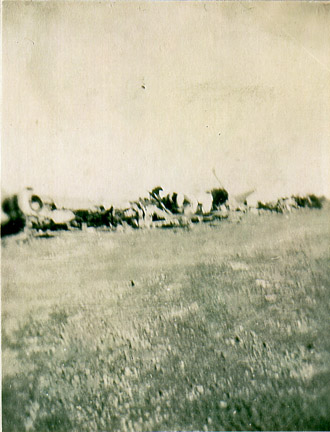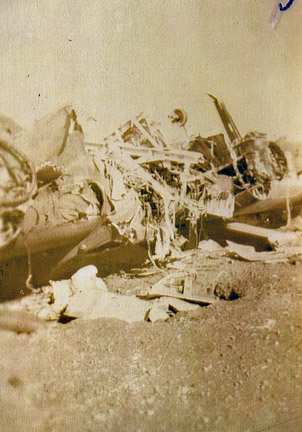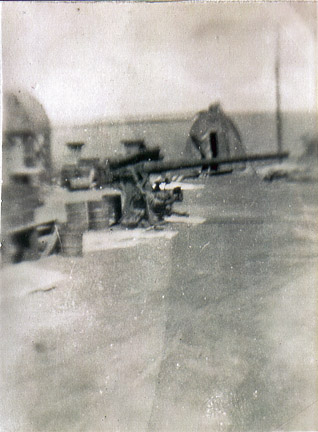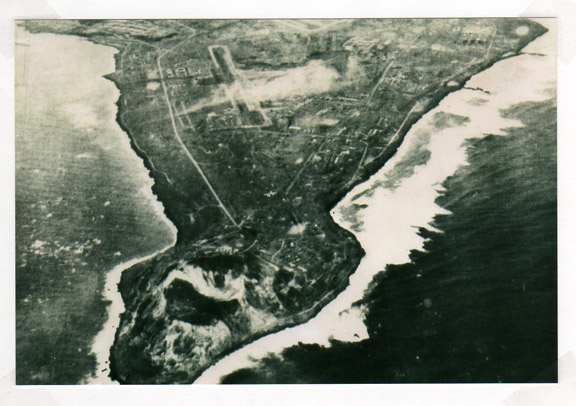
Aerial View of Iwo Jima. Photo courtesy of
Gareth W. Rossen, 1946.
Most of the
caves were on one level but there were a few two levels or
more. The temperature was hot in some. The best cave on the
island was the General's (Kuribayashi) cave (picture #7). A
few of the caves are as follows:
I am sending
17 pictures attached to this e-mail.
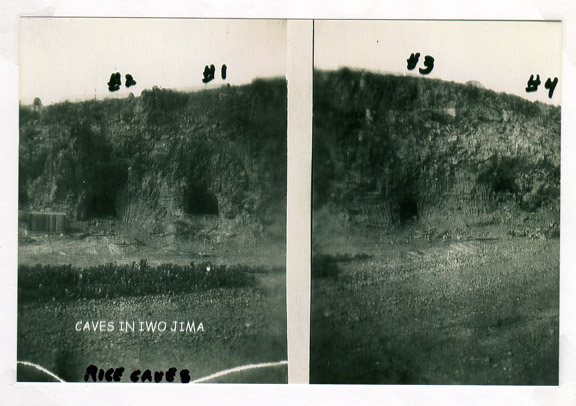
Four
Rice Caves. Photo by Gareth W. Rossen, 1946.
There are 4
caves sid by side. All were filled with rice. The caves were
approximately 15 feet high, 12 feet wide and at least 70
feet deep. These caves are filled within 3 feet of the top.
Rats of all sizes were everywhere. The rice was hauled away
by trucks. We cleaned the caves, installed electrical lights
along with an outside generator. This was to be our typhoon
shelter. The first typhoon came in late 1946 or early 1947.
Records should indicate. This cave is #1 on the
pictures.
This cave (no
picture) is on the N. E. end of the island on the main road.
The opening was approximately 15 feet from the road. The
opening was only 5 feet high and 3 feet wide. After entering
10 feet there was a decline of 60 degrees for 20 feet which
opened into a room. There were 20 boxes of Sake stacked
along the wall (both clear and milk Sake). Most of the men
took a bottle each. The room was HOT around 105 with a
terrible smell. There were 5 or 6 Japanese soldiers, fully
clothed, on the floor on the other end of the room. Their
bodies were dried like leather. We didn't go down to the
next level due to the stench and heat.
The next cave
(no pictures) was on the south side of the island. After the
typhoon came the rains washed out where the Marines had
sealed the caves. The opening were about 2 feet by 3 feet.
We opened one of the caves all the way so we could get in.
We went inside and found Japanese soldiers, fully clothed,
some were wearing their bandages. There were dug outs along
the walls of the caves. These were probably used for
sleeping and hiding.
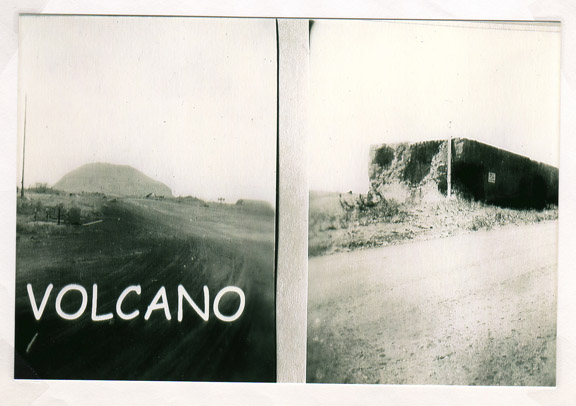
Mt.
Suribachi and the General's Cave. Photo by Gareth W. Rossen,
1946.
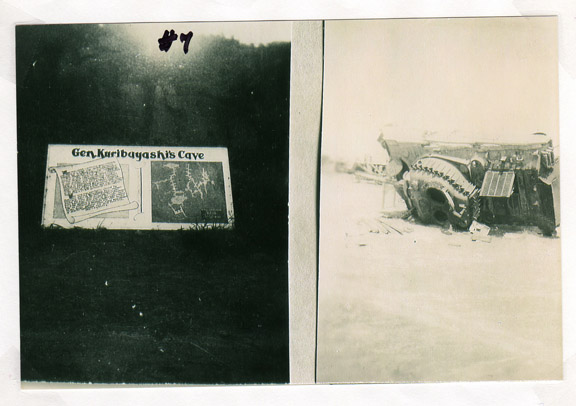
Sign for
General Kuribayashi's Cave. Additional photo is of a knocked
out Sherman. Photo by Gareth W. Rossen, 1946.
This is the
Japanese General's cave (picture #7). It appears as a green
oasis, 300 feet square with a few palm trees and coconut
trees. There were very little vegetation on the island,
making this cave area outstanding. There was a large sign by
the entrance as shown in the picture. After entering through
a hall of about 8 feet, in a high room, no furniture. There
were other rooms leading off including a bathroom with a
half sunken bathtub in the floor.
You wanted
more details. Details your get. The Generals Cave was not a
bunker. I'll start at the beginning. I drove approximately
110 feet to the right of the Generals entrance.
In the jeep with me were T5 Walker, T5 Willinghoff, and PFC
Selby. Walker got out of the jeep first and hollered to me
that I had just straddled a land mine. I got out and as he
said I had just done that. I got back into the jeep and
backed straight (young and stupid). I drove to the other
side of the cave entrance and drove up the incline
approximately 60 feet. There was a lot of brush on the right
side.
We then went
to the cave opening. There was a sign saying " OFF LIMITS "
approximately 15 feet in front of the opening. Once in the
cave, as I said before there was a large room. Leading
off was a smaller room with a small table and chairs, all
busted up. There were Japanese documents there on the floor
(maybe a dozen or so.) We did not take any paper with us.
There was a small bath room with a tub half in the
ground. There was an air shaft, 4 feet wide going straight
up for about 8 feet. Then at a approximately 60 degree angle
it goes up around 50 or 60 feet to the air opening. The
opening had bars. A rope was tied to the bars and extended
all the down to the floor. We climbed up and were able to
see our jeep parked outside. We didn't notice the bars from
the outside as we parked due to the brush that I mentioned
earlier. (Sure glad it wasn't the MP jeep).
You inquired
about inside pictures of the caves. Having only a 620 box
camera with no flash, no inside pictures. The only place we
could develop our pictures was in a dark room in our
company. All the supplies were by the Army Special Services
Dept.
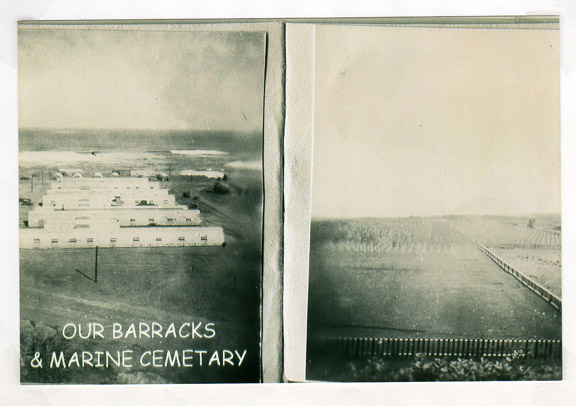
Barracks
and the U. S. Marine Cemetery on Iwo Jima. Photo by Gareth
W. Rossen, 1946.
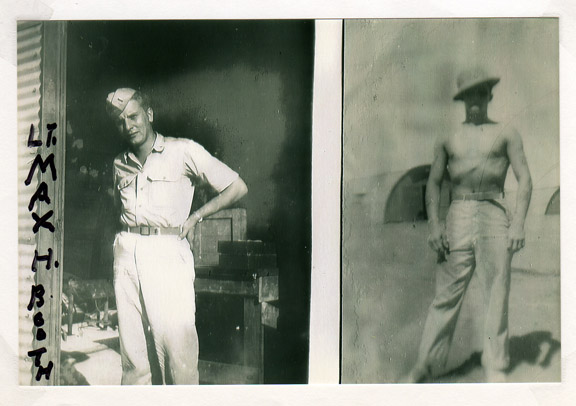
1st. Lt.
Max H. Booth, Ordinance 199th Depot & 3605th HAM Shop.
Photo by Gareth W. Rossen, 1946.
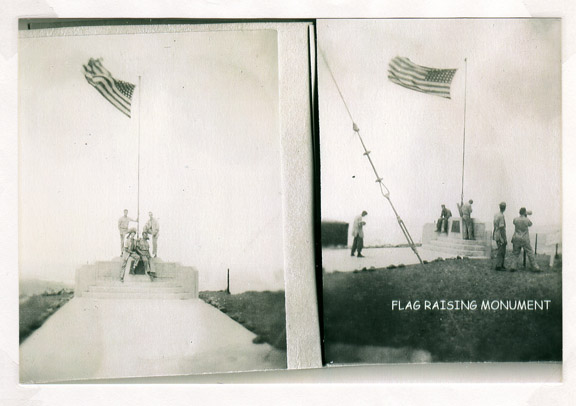
Mt.
Suribachi Flag Raising Monument. Photo by Gareth W. Rossen,
1946.
All the marine
cemeteries were very kept up by the Quartermaster Co.
I have a lot
more details on these if needed. Thanks.
I have three
other little stories to send to you as follows: One day on
Iwo, I and two other men went up to the old south air strip.
We had heard of this so we went to see. It was a great big
hot hole in the ground. (a big one) The liquid in it was
boiling. We thew a 5 gal can in and it disappeared. Then we
put a 55 gal. drum in and it was gone just as soon. So we
got the hell out of there. Ha Ha
As I said
before we had no place to buy beer. It came in once a
month on LST boats and they sent it to the part time PX
that we had . You could buy it there by the case HOT
only. If you knew some one in the Quartermaster you could
take it down there and they would put it in their
refrigerator but it cost you half of what you put in. I was
glad that I didn't drink.
We had an ammo
area on the north side of the island high up on the beach.
There were three buildings half in the sand there. In them
were all kinds of ammo. There were a lot of cases of 45 cal
for the 45 cal guns and the thompson machine guns. Also here
were cases of hand grenades. We would load the two and half
ton truck up and go down to blue beach were we had made a
firing area. We could do this as long as Lt. Booth was with
us. He never wanted to come so he told me as lomg as I was
with them it would be OK. We would use the 45 cal guns,
machine guns and ths hand grenades. We were lucky no
one was ever hurt BUT when we got to the company area all we
could hear was nothing -- just their lips moving for a hour
or so. Oh yes, the guns we had to go to the depot to get
them.
In April or
May in 1947 an, order came out to send home all men with a
test score of 60 or below to be discharged. We lost 7 or 8
men to that order.
In June of
1947 they stopped all one months promotions in Hawaii, Guam,
Saipan,Tinian and Iwo Jima. At that time you would have to
have so much time in grade. I had already been promoted to
S/ Sgt.
This one is
about a General Court Marshal of the man that ran the
part time PX. His first name was Ray and he was from MO. The
same as where I was from then. They sold all kinds of things
other then soda, beer was sold HOT by the case. He keep very
little records of sales. I think he must have had a lot
of the money as he would stop by about every two weeks on
his way to the P.O. across from our area. He went to
the P.O. to by money orders to send home. I was from Mo. too
and he liked to talk. To take down Court Marshal records
they had a girl from Guam to take notes. What time she
wasn't taking notes on the Court Marshal she was to help out
in he P.O. (Post Office) where S/gt Wilks was in
charge. There a good story about that, BUT I won't go into
that. You know why. I don't know what happen in the balance
of the Court Marshal.
We had
Wednesday and Saturday afternoons and all day Sundays off so
we had a lot of free time. In the HAM shop we had a D7 and a
big road grader which we use to level a race track (one
fifth mile). We also had a big roller to use on the track.
To have some thing to run on it we did the following. We
took old junk jeeps and took the wheel, tires, body and
seats all off. Now we had to start putting it back together
again. We took the tires and wheels from junk jeep trailers.
One of the men in the company would weld them onto the
old drums (making SURE that they ran true). Then we went to
where the old junk airplane were put at. We would get an
airplane seat and a five gal. gas tank. We then put both of
them on.
Airplane
graveyard, Iwo Jima. Photo by Gareth W. Rossen, 1946.
Airplane
graveyard, Iwo Jima. Photo by Gareth W. Rossen, 1946.
Radar Installation and artillery piece, Iwo
Jima. Photo by Gareth W. Rossen, 1946.
We had to
adjust the stearing wheel and hook up a lot of other things.
We used ONLY the standard gears (no low range). You
could start it up and with the small tires and wheels
you could throw dirt about 15 feet in the air ( a lot of RPM
). To do all this we had three men to a car. There were
usally 3 or 4 cars running, a lot of dust. So this is where
we would put in a lot of time. This track was on the
south side of the island, there was a pill box close to this
place. When a man was on orders to go home he would give his
part of the car to another man that was staying.
This is about
a death and another General Court Marshal. Some time in late
June I went into the hospital on Iwo with xxxxxxx . On
the last day there around 8:00 PM S/Sgt. Wilks and two men
from my company (one was a PFC Albright the other one is
????). I don't remender who. They had been drinking hot
beer and were pretty well along. S/Sgt. Wilks was on
shipping orders along with me to go home. They were
having a good time. He said that they had been up to the CWS
area had gotton some smoke xxxxxxx. They had taken
them down to the HAM shop and threw them down were
the xxxx were at (no ammo) just having fun they said.
He knew that I was to out of the hospital in
the morning and wanted me to come with them. I said NO!
So they left. They went back to the CWS area to get some
more smoke grenades but having to much to drink they
got the wrong ones they had picked up white phosphorus
grenades in place of smoke grenades When S/Sgt. Wilks
pulled the pin he failed to get rid of it in time and it
went all over him. PFC Albright got some on both his hands
and a little on his stomach. The other man had a small
spot on his forehead. S/Sgt. Wilks died about 30 minutes
after they had gotten him into the hospital. PFC Albright
was up for a General Court Marshal. Then I left before it
really got started. The other man I don't know what they did
to him.
In the Iwo
Jima area they were having a lot of trouble with the C46
airplanes. The one that I was on in the first part of 1947 I
was going to Japan for 5 days R&R ( for
the officers it was A&A). Well this plane was
having motor trouble. When we got to Japan the plane was
grounded (gas leaking). On the way back the C46 plane again
was having motor trouble. We landed OK and was glad to
get on the ground. Now this plane took off to Guam but
crashed in the water close to the beach.
There was a
team of base ball players that were sent to Japan to play
ball. On the way back in a C46 airplane it over shot the air
strip and crashed into the water about a mile off the coast
of Iwo Jima. This was on the south east side of the
island. There was a Capt. Queen, a warrant officer, 2 or 3
crew men and the whole baseball team. NO Survivors. Also
some time in early 1947 a larger plane (silver) crashed, the
whole tail assembly came off. The plane crashed and they
lost a lot of mail. This all should be a matter of
record. Last of the notes.
I was going
through some old boxes I had stored away for a long
time. I found an old 3 by 5 inch note book that I had on Iwo
Jima. I keep it in my office there to write notes on what
happen that day, so I would have something to write home
about. I would write that night or the next day, then cross
it off the book. This book was about half full of things.
Some of the things in it were as follows:
Caves that I
have talked about.
The next three
are about the C46 airplanes that went down on Iwo Jima ,
Guam and Japan. Records should show as follows:
Some time in
the first part of 1947 the Army sent a team of base ball
players to Japan to play. They lost the games. On the way
back, the C46 plane it over shot the air field and crashed
in the water approximately a half mile out. As I
remember there were a Capt. Queen, a warrant officer and 3
enlisted men plus the baseball team in the plane.
NO one got out!
One more
thing. The plane that went down with the ball team also had
a nurse on it. After looking at by little note book closer I
could see a N/??? after the ball team. (Not very clear
notes- just like a 18 year old boy would do) On this
plane...it was coming from Japan and would have landed on
strip #3 using the north to south landing strip. Looking at
the map of Iwo Jima you find that strip and draw a line down
the center to the water and it will pass over our company,
the Post Office and HQ & HQ Co. They say it landed 15
miles out ??????.
Just after
this, a few others and I left to go to Japan on
R&R. ( For Officers that was changed to A&A.)
The plane was having engine trouble on the way there. When
we got there we found out the plane was grounded it had a
bad gas leak. We had another C46 on the way back
to Iwo Jima. It also had engine trouble but we landed
OK. This plane went down on the coast of Guam, in the water
close to the beach.
I don't
usually ask for help, but in this case I do need some. My
best friend on Iwo Jima was a T/5 Cpl. John Willinghoff.
Records that I had there showed when each man was to go
home. John was due to leave about 6 months after me.I was
discharged on July 30, 1947. He was from Texas. He stopped
at my home in Lebanon, Mo, looking for me some time in
December of 1948. My mother told him that I had moved
to Illinois for work. At that time he was working for an oil
company in Texas or Oklahoma. I have been trying to find any
thing about him for over a year. If anyone can help, I would
appreciate it. If anyone can find any thing on him or his
family, please let me know.
.....Gareth W.
Rosson
Search for Genaust
yields nothing new
BY DAVID
SINGLETON
STAFF WRITER
Published: Sunday,
September 14, 2008
Updated: Sunday,
September 14, 2008 4:22 AM EDT
The latest attempt
to recover the remains of the Marine who filmed the
flag-raising at Iwo Jima - a cause championed by Scranton
business Bob Bolus - has ended like the first.
An investigative
team from the Defense Department's Joint POW/MIA Accounting
Command wrapped up a 20-day mission to Iwo Jima last month
without finding any trace of Sgt. William H. Genaust, JPAC
spokesman Lt. Col. Wayne Perry said. It was the second
search in two years.
Mr. Bolus, who was
pursuing a new lead about the possible location of Sgt.
Genaust's remains even as JPAC investigators were on Iwo
Jima, said he's not giving up.
Sgt. Genaust, then
38 and a combat photographer with the 28th Marines, shot the
iconic footage of the raising of the American flag on Iwo
Jima's Mount Suribachi on Feb. 23, 1945. He was killed by
machine-gun fire nine days later while helping to secure a
cave on the island, and his body was never recovered.
The JPAC team,
consisting of nine Americans and two representatives of the
Japanese government, focused its search for Sgt. Genaust on
the southwest side of Hill 362A in an area where the 2007
mission had identified two collapsed caves that warranted
additional investigation.
"The team excavated
the entire southwest quadrant with negative results," Col.
Perry said in an e-mail from Hickam Air Force Base in
Hawaii, where JPAC is headquartered. "No remains were
found."
He said JPAC
continues to look at all leads and evidence related to Sgt.
Genaust, including additional information it "just received"
and turned over to its historian for review.
Mr. Bolus said the
source of that information is Gareth Rosson, an Army veteran
from Canton, Ill., who was stationed on Iwo Jima for 18
months in 1946-47.
In August, while the
JPAC team was on Iwo Jima, Mr. Bolus met with Mr. Rosson in
Canton. Mr. Bolus said Mr. Rosson, 80, shared with him a
chilling recollection.
Mr. Rosson, he said,
remembers seeing a wooden plaque reading, "Bill Genaust died
here," on Hill 362A - but on the north side, not the
southwest side.
"He was very vivid
on that. He was very vivid on the details," said Mr. Bolus,
who passed the information on to JPAC officials, who have
since contacted Mr. Rosson.
Col. Perry said JPAC
will convene a review board to examine what was learned
during the latest mission, along with any new information,
and make a recommendation on whether another mission to Iwo
Jima is warranted. At this point, he said, there are no
immediate plans to go back to the island.
Mr. Bolus, who has
been crusading to recover Sgt. Genaust's remain since
reading about the Marine three years ago, has offered to
take his own team of investigators to Iwo Jima at his
expense to assist JPAC with the search. He's been repeatedly
rebuffed by the Defense Department.
He is trying to get
an audience with the Japanese government, which controls
access to the island, in the hope it will be more
receptive.
Contact the writer:
dsingleton@timesshamrock.com
From an article that
appeared in the The Scranton Times Tribune on Sunday,
September 14, 2008.
Search for Genaust Yields Nothing
New
Note: To view
images taken by the web master of World War II Stories -- In
Their Own Words during his year on Iwo Jima, please click on
the following link to my World War II Stories Photo
Album:
WW
II Stories: Iwo Jima Photo Album
1965-1966
Did YOU serve on Iwo Jima?
Did you know that
there is a group of veterans who have gotten together to
form an association of servicemen, no matter what branch of
service, who served at one time or another starting at the
invasion of the island on February 19, 1945 and continuing
until the island was eventually returned to the Japanese in
1968?
Iwo
Veterans Organization
We, at the
Iwo
Jima Memoirs web site wish to offer to Mr.
Gareth W.
Rosson our
most profound THANK YOU for his poignant story of his
personal experiences -- during his tour of Iwo Jima and
especially for allowing us to share those
memories.
Original story transcribed on 6 March 2007
Story modified
on 30 March 2007
Did YOU serve on
Iwo Jima?
Do YOU have
a story to tell?
Do YOU have a picture or pictures
that tells a story?
Contact me, Joe
Richard and I can help by adding YOUR story to my site
devoted to veterans who served on Iwo Jima.
Check out my
other web site on World War II. Click on the Image
Below:


